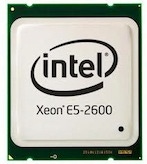March 8, 2012


Intel Xeon E5-2600
Intel Corp.’s new Xeon processor E5-2600 is taking aim at the data center and cloud computing markets, with a particular emphasis on storage and communications systems.The new Xeon processor arrives roughly one week after AMD acquired SeaMicro for a cloud server push.
Intel claims the new Xeon processor addresses cloud service provider needs across compute, storage and network infrastructure. The Xeon also attempts to address the rapidly growing cloud server market, where sales are expected to increase by 300 percent by 2015.
From Intel’s perspective, the “key requirements to enable IT to scale are performance, energy efficiency, I/O bandwidth and security,” adding that “the new Intel Xeon processor E5-2600 product families are designed to address these requirements, and become the heart of the next-generation data center powering servers, storage and communication systems.”
Intel Xeon processor E5-2600 product features include:
Eight cores per processor and up to 768GB of system memory, increasing performance of the Intel Xeon processor E5-2600 product family by up to 80 %
Support for Intel Advanced Vector Extension (AVX) that doubles the performance on compute-intensive applications such as financial analysis, media content creation and high performance computing
Additional built-in technologies such as Intel’s Turbo Boost Technology 2.0, Hyper-Threading Technology and Virtualization Technology providing flexible capabilities to increase the performance of IT infrastructure
Reduction of the total cost of ownership by improving energy efficient performance more than 50 percent, compared to the previous generation Intel Xeon processor 5600 series
Support for tools to monitor and control power usage such as Intel’s Node Manager and Data Center Manager, giving IT managers “accurate, real-time power and thermal data to system management consoles”
Intel Integrated I/O (IIO) and Intel Data Direct I/O (DDIO) which allow “Intel Ethernet controllers and adapters to route I/O traffic directly to processor cache, reducing trips to system memory reducing power consumption and I/O latency”
Direct integration into the microprocessor with the I/O controller supporting PCI Express 3.0, reducing latency up to 30 % compared to earlier processor families. PCI Express 3.0 can almost triple the movement of data into and out of the processor
That’s a lengthy laundry list of capabilities. Now, will cloud services providers embrace the new Xeon processor? We’ll be watching.
About the Author(s)
You May Also Like


